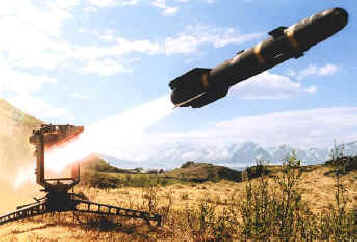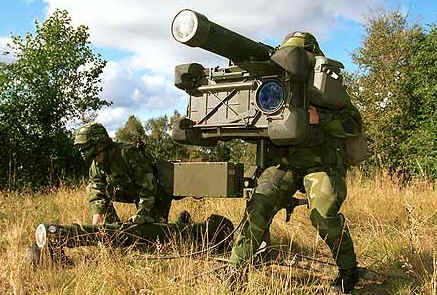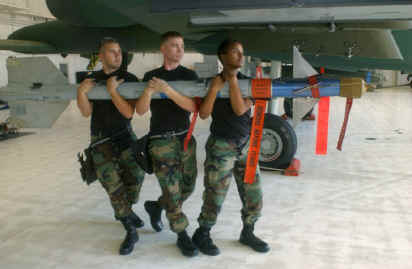Modern military aircraft are extremely expensive and
not easily replaced. While a great deal of thought is devoted to keeping
them safe while airborne, little thought or resources are devoted to keeping
them safe on the ground where they spend the vast majority of their time. The
vulnerabilities of fixed airbases to air and missile attack is recognized and
plans exist to counter those threats. The threat from sappers is known and aircraft are guarded. However,
new sophisticated man-movable
weapons allow commando teams to destroy aircraft at long ranges. These are
not man portable weapons that infantrymen can carry long distances, but they are
small enough so that a team can move them several hundred meters after they
are dropped by parachute, a small helicopter, a boat, or a civilian automobile.

For example, the 100 lb laser-guided Hellfire missile has a range of ten miles. The Norwegians developed a lightweight pedestal to allow ground-launch by small teams. (right) Specially trained teams of air commandos can use this weapon to become "aircraft snipers." Teams can deploy several Hellfires within ten miles of an airbase while someone moves within direct sight of parked aircraft to aim a laser designator from well outside the airbase perimeter while Hellfires launch from miles away. A $100 million aircraft can be easily destroyed while base security personnel run about trying to determine what is happening.
If a commando cannot lase the ramp area where aircraft are parked, he can still destroy aircraft that are taxiing, taking off, or landing. He can even down flying aircraft, especially large aircraft and helicopters. Air commandos may also carry large .50 caliber rifles to shoot up aircraft from 1000 meters away. As a result, air commando teams can set up along common aircraft routes for "aircraft sniping" with heavy rifles and small missiles. They may wait for days at a location for an aircraft to pass by. Mountaintops will be a favorite hunting ground and rooftops of large buildings. These weapons may also be mounted on small commercial trucks to blend in with civilian traffic or on a small boat. In 2005, Iraqi insurgents ambushed a British C-130K transport shortly after take-off from Balad airbase. They quickly shot it down with an old 20mm anti-aircraft gun killing all ten persons aboard.
 Another weapon for air commandos is the 12.5
lb shoulder-fired Stinger surface-to-air missile with a range up to five miles. However, the
heat-seeking Stinger
has a 3 lb warhead that usually just causes engine damage and rarely downs an
aircraft. Larger pedestal mounted surface-to-air missiles
can be used, like the RBS-70
(left) sold by Sweden, which launches a larger missile directed by a laser
guidance beam until the moment of impact. The missile has its laser beam riding system in the tail
so its impossible to
jam. Moreover, the operator can aim the missile at the aircraft's cockpit
for a sure kill. Even
larger missiles can be used such as the AIM-9 Sidewinder. (below) This
185 lb
rail-launched air-to-air missile with a range of ten miles has a big 25 lb
warhead. These can be mounted on a pedestal like the Hellfire and
launched by small teams.
Another weapon for air commandos is the 12.5
lb shoulder-fired Stinger surface-to-air missile with a range up to five miles. However, the
heat-seeking Stinger
has a 3 lb warhead that usually just causes engine damage and rarely downs an
aircraft. Larger pedestal mounted surface-to-air missiles
can be used, like the RBS-70
(left) sold by Sweden, which launches a larger missile directed by a laser
guidance beam until the moment of impact. The missile has its laser beam riding system in the tail
so its impossible to
jam. Moreover, the operator can aim the missile at the aircraft's cockpit
for a sure kill. Even
larger missiles can be used such as the AIM-9 Sidewinder. (below) This
185 lb
rail-launched air-to-air missile with a range of ten miles has a big 25 lb
warhead. These can be mounted on a pedestal like the Hellfire and
launched by small teams.
 Air commandos will prove effective
attacking unsuspecting
aircraft. Aircraft are normally alerted when they are targeted with the
help of radar
warning devices. They fly fast and maneuver over enemy forces and
constantly look around for threats. However, in transit between their
airbase and enemy forces pilots are often bored and fly straight and
steady. A missile launched by an air commando team may not be noticed.
Air commandos will prove effective
attacking unsuspecting
aircraft. Aircraft are normally alerted when they are targeted with the
help of radar
warning devices. They fly fast and maneuver over enemy forces and
constantly look around for threats. However, in transit between their
airbase and enemy forces pilots are often bored and fly straight and
steady. A missile launched by an air commando team may not be noticed.
Aircraft provide the fastest method to insert and resupply air commandos. However, helicopters are slow and vulnerable and so are fixed-wing transports. A modern military needs a method of dropping commandos from jet aircraft. The US Air Force evaluated the B-1 bomber for this role, but jumping out the bomb bay was deemed dangerous with the location of the B-1's engines. Building a jet aircraft for this role is expensive and unnecessary since several companies now sell supersonic executive jets. These can be modified for parachute operations to provide a safe method of inserting and supplying commandos in high-threat areas. These jets must slow down to deliver their package of paratroopers, while Generals enthusiastically use them for VIP missions too.
A final role for air commandos is long-range airbase defense patrolling. If they are experts at destroying aircraft as aircraft snipers, they are experts at defending against such attacks. They should be assigned to continually evaluate enemy air commando threats outside airbases to provide advice to pilots and air traffic controllers. They will be integrated into the search and rescue process too. If an aircraft is downed by an enemy sniper team over supposedly friendly territory, the helicopter dispatched to rescue the pilot should carry an air commando team. After the pilot is picked up, he will guide the helicopter near the area where the missile or gunfire originated and the air commando team will be dropped off to hunt down the anti-air team.
When German ME-262 jet fighter aircraft appeared toward the end of World War II, American fighters could not shoot them down. The solution was to locate their airbase and destroy them on the ground. Likewise, a nation that cannot afford or obtain modern jet fighters may choose to train and equip hundreds of air commando teams. During a war, these teams can make their way toward enemy airbases and cause chaos. The long reach made possible by lightweight precision guided weapons makes airbase defense very manpower intensive. Many aircraft will be forced to operate from distant bases reducing their effectiveness, while other aircraft will be forced to adopt tiresome tactics like spiral take-offs and landings and fly longer and varied flight paths.
Nevertheless, air commandos will down aircraft, just like Naval Commandos sink ships. These units must be formed and trained in peacetime specifically to destroy enemy aircraft. Forming such units in wartime is difficult since all resources will be committed to other forms of combat. A nation with a well-equipped air commando force can pose a greater threat to a modern air force than fighter aircraft and sophisticated air defense systems. They will surprise a modern air force that never anticipated such a threat.
©2015 www.G2mil.com